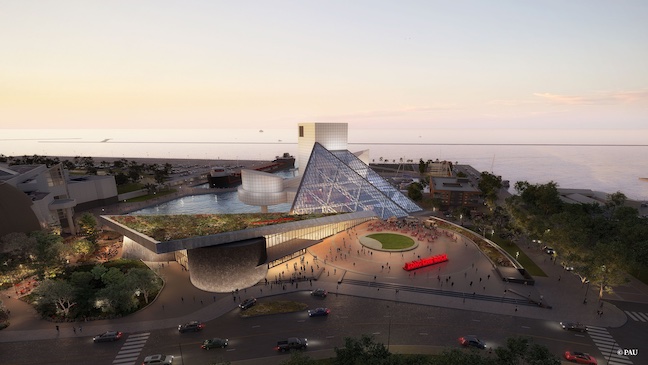
The expansion, which will beging with construction this fall, will feature a new entry lobby and publicly accessible space; exhibition spaces, offices, state-of-the-art education center and a 6,000+-square-foot multipurpose venue. It will add 50,000 square feet to the museum.
Designed by Practice for Architecture and Urbanism (PAU), the expansion will integrate the iconic original building designed by I.M. Pei with the urban Cleveland lakefront, while increasing the size of the nuseum by one third. It takes cues from the visual language of Pei’s original 1995 signature glass pyramid while preserving its distinct identity as a Cleveland landmark and activating the surrounding streetscape and lakefront.
“The renowned architecture of the Rock & Roll Hall of Fame is symbolic of the innovation and creativity of generations of music icons,” said Rock & Roll Hall of Fame Museum President & CEO, Greg Harris. “30 years after we broke ground on the original structure we embark on this next chapter in the Rock & Roll Hall of Fame’s legacy, including expanding the museum’s world-class education and exhibition offerings, and we are thrilled to partner with the architectural and design visionaries at PAU, including Vishaan Chakrabarti.”
“This transformation will expand the Rock Hall’s iconic structure to meet the demands of its evolving mandate: to showcase the past, present and future of rock & roll as the defining sound of each generation’s youth,” said Chakrabarti, Founder and Creative Director of PAU. “Our design welcomes visitors by pulling the forces of the City, the Lake, and Pei’s Pyramid together into a new triangular composition that centers on a dynamic, aural, and inclusive public interior that flows from the streets to the waterfront—a destination that declares this must be the place.”
PAU’s design reinterprets Pei’s organization of solid shapes “dancing” around a central transparent pyramid. A triangular-shaped building interlocks with and extends outward from the original glass structure. Specific programmatic elements are articulated as solid shapes asymmetrically arranged under a tilted triangular roof. Clad in black steel and specular granite, the façade evokes Cleveland’s industrial past while representing a contemporary counterpoint to Pei’s design.
Leave a Reply
You must be logged in to post a comment.